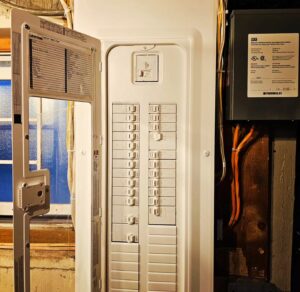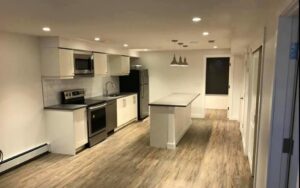
As modern electrical needs and demands have increased, the same demand for higher and more reliable power. To meet modern electrical needs and ensure your electrical system is safe, you might have to upgrade your residential electrical panel.
At some point, any homeowner will likely find themselves in the position where an upgrade is necessary. When that time comes, it is important to know what to expect and how much it’ll cost. That way, you can make the most informed and cost-effective decision for your home and lifestyle.
Table of Contents
ToggleWhen and why replace an electrical panel?
Like all things, electrical panels have a set lifespan before they eventually need to be replaced. The older the wires in the panel, the more risk there is of short-circuiting or even sparking hazardous electrical fires. It is possible that your older panel is not up to recent code, and for safety reasons, an upgrade is needed. Other times, it may just be that your household’s power needs have changed and so an upgrade is in order. Either way, knowing the signs or reasons you need an upgrade or replacement will help with that final decision.
Signs it’s time to replace the electrical panel
Regular maintenance and checkups by a professional will help keep your electrical panel in excellent condition. Generally, this should be done at least every 3-5 years. That said, any problems that come up before, such as an overloaded circuit, can pose premature issues. If that happens, don’t wait to buy a replacement and risk a safety hazard. Instead, knowing the signs of when it’s time to replace will help keep your home safe.
Breakers trip frequently: If your safety panel is getting old, it may wear down and be more at risk of power surges. When this happens, the circuit breakers will trip more often as a result. It may also be that your home’s electrical demands are too high for the electrical panel and is causing it to trip more often.
Breakers don’t reset: A related problem with breakers tripping is if they don’t reset afterward. In this case, it’s likely a fault with the electrical panel itself. A professional electrician is the best way to identify the problem and then either repair or replace it.
Burn marks or odours: The wires inside the panel can also wear down, and as they do, it risks causing electrical fires inside the panel. That is a more severe problem that should be dealt with immediately by a professional. If any wires become exposed, that is another safety hazard that should never be ignored. Turn off the power and call in a professional right away.
Flickering lights: If the problem isn’t fixed at the light source, it may be a problem with a lack of energy. You might notice lights flickering when the microwave runs or the furnace kicks in. Old homes have fewer circuits, so they aren’t able to meet the demands of modern electrical needs. Replacing your old electrical panel or adding more power will help stop this problem.
Other reasons to update the electrical panel
If your electrical panel needs constant repairs, it is more cost-effective to upgrade it instead. The same can be said if you own an older fuse box instead of a modern circuit panel. Newer models offer more power, better efficiency, and improve overall safety in the home. To decide, consider some factors or any changes in your lifestyle that may benefit from an upgraded electrical panel.
Adding new appliances: Adding or updating your electrical appliances will add value to your home but only with the right power. Old panels can quickly become overburdened and end up blowing a fuse or even damage the new appliance. If you are planning to renovate and add appliances, also plan to upgrade your old panel or add more power.
Save cost and increase value: New electrical panels will run at a much higher efficiency than old models. Not only will you be able to use more power, but it also saves on electrical bills. The home’s overall value will also go up with a new panel that offers peace of mind and savings for many more years. This is especially true if your home has an old panel and system that is not up to code. Buyers will be deterred by this.
You have a fuse box: Unlike modern circuit panels, fuse boxes offer fewer benefits and overall safety. There is also less room to customize, such as adding more power or installing a ground-fault circuit interrupter. Any fuses that blow from a power surge will cost extra money to buy replacements.
Once you’ve decided to upgrade, it’s time to consider how much does it cost to upgrade your electrical panel. There are a few different ways available, and each will vary in cost. Keep in mind that while it is a major investment, upgrading electrical panels is often the safest thing to do and very worthwhile.

Types of upgrades and replacements
The cost of upgrading or replacing an electrical panel depends on what change is planned and the work involved. Adding more circuits, increasing amperage, or switching from a fuse box to a circuit panel will vary in cost. Reports from HomeAdvisor state that on average, you can expect to pay between $500 to $1,700 for an upgrade. Higher-end costs can easily reach upwards of $4,000, depending on how much labour is involved.
Upgrading to a higher amp
Upgrading an electrical panel to support more power is commonly done, especially to accommodate higher energy demands. Not only that, but it’s a guaranteed way to increase security and safety in a home. Lower electricity homes may run on a 60 to 100-amp box but also run much closer to maximum capacity. That increases the risk of overloading the circuit or causing costly damage to the panel and any connected electronics. The standard for most homes is to use a 200-amp box to avoid any capacity issues and have elbow room for increased future power demands.
The cost breakdown for upgrading amperage also includes the labour fees of a professional. Most work can be done within a day by a certified electrician, but they charge per hour. Different companies and electricians will vary in fees from between $50 to $100 per hour. The below figures are cost estimates.
100-150-amp upgrade: $800 to $1200
200-amp upgrade: $1,300 to $3,000
400-amp upgrade: $2,000 to $4,000
If the electrical panel meter box needs to be upgraded, that will be a different cost. The benefit of upgrading, however, is both added safety and more accurate readings. These readings can then be used to increase the efficiency and energy savings of the home.
100-amp box: $55-$250
200-amp box: $85-$680
400-amp box: $480-765
Secondary electrical panel
Adding a whole breaker box is also an option, particularly when the old panel box is full. A secondary box can increase the overall number of circuits or add power to new rooms or additions.
Secondary panel box cost: $500
The best way to get an accurate power estimate is to have a professional do a “demand calculation.” According to the Canadian Electrical Code (CEC), this helps calculate how much electrical power is needed for your home’s size and appliances.
Keep in mind that the cost may increase if the power supply line needs to be upgraded to support the added power. In that case, the cost of any excess work, such as digging up the power line, will add even more. Before upgrading your electrical panel, call the power company to see if your supply line can support more power.
Fuse box vs circuit breaker
While fuse boxes and circuit breakers both prevent hazardous overloads, they do so differently. Fuse boxes work faster, but when a fuse blows, it melts and must be replaced. Circuit panels, on the other hand, are better suited to modern needs and are easier to reset. Changing to a circuit panel may also be necessary if breakers, such as a ground-fault circuit interrupter (GFCI), are required.
Fuse box
The benefit of a fuse box is how quickly they can flip and prevent electrical fires caused by overloaded circuits. When this happens, the fuse melts, cutting off the line of power. The downside is that fuses are expendable and must be physically replaced. Fuses themselves will cost between $5 to $40 for each new fuse. Replacing them in the dark can be a challenge, as is replacing the fuse with the wrong voltage. If that happens, the fuse box can overheat and result in much more costly repairs.
Circuit breaker
When a power surge occurs with a circuit breaker, it triggers the panel to throw the switch and turn off the current. To reset the breaker, turn the switch back on to reset the circuit and restore power. That also makes it easier when working with wiring in any part of the home as power can be targeted and turned off in specific rooms.
Upgrading to a circuit breaker is also necessary when adding things like a GFCI. These are required in areas where water is involved, such as kitchens or bathrooms, to prevent hazards. Circuit breakers can also be outfitted with more power down the road to support changing electrical demands.
The cost of switching from a fuse box to circuit breaker
Upgrading to a circuit breaker is a matter of both electrical needs and convenience. Most fuse boxes are 60-amp, while a circuit breaker starts at 100-amp and can go up to 400-amps. Circuit breakers are also better equipped for handling and providing more power and preventing overloads.
Average cost to replace fuse box: $1,500 to $2,000, including labour
The costs will also vary depending on whether any rewiring is necessary or whether renovations are needed to meet safety code standards. Having a professional inspect your home is the best way to estimate the amount of work and how much does it cost to upgrade your electrical panel.
Moving electrical panels
Moving an indoor electrical panel will vary in cost by the amount of work required and the distance it is moved. If the panel is being relocated just a few feet, it will be less expensive than moving it outdoors or to a new floor. The costs will cover everything from adding new wires, opening and resealing drywall, or rewiring the house.
Average cost to move panels: $1,000 to $2,000
Depending on the scale of work and relocation, it’s best to talk to a professional for an accurate estimate of the final cost. Each home will be different, and the scale of work will likewise vary as well.
What to expect during an upgrade?
Keep in mind that during an electrical panel update, your home’s power will be turned off. That may seem obvious but plan for the day so that you aren’t caught unaware. Unplug any electronics in case power is turned on and off which may potentially cause problems. Ask your electrician if there are any areas of the house they need to access, such as the basement, attic, or water tank. Following the work, there will be an inspection to ensure everything is up to code. The electrician should handle this as well and will be familiar with the process.
Electrical panel maintenance
Once your electrical panel has been upgraded, you want to ensure that it stays in top condition for many years. The best way to do so is to have your electrical contractor come back for regular maintenance and inspections. They’ll check the electrical panel and connections and do a thermal test for any abnormally high temperatures. As for DIY maintenance, if your home’s needs ever change or you plan to add more appliances, check your panel first. If it can’t support the load, then upgrade it first. If circuits keep tripping or there are flickering lights, call an electrical contractor in to have a look. When it comes to electrical problems and services, never wait until the problem becomes worse.
Upgrade electrical panel: never DIY
In general, electrical work should always be left to the pros, and electrical panels are no exception. Everything from demand calculations to the actual installation or upgrade should be handled by a professional. With the right training, experience, and tools, they’ll safely handle any electrical services. Legally as well, professionals provide all the right insurance. They’ll know what permits are necessary or what electrical and safety codes are in place. When they service your home, it is guaranteed to increase in value.
DIY work, however, doesn’t have that same guarantee. The risk of hazards or personal injury is higher, as is installing a new panel wrong. Potential buyers will also note professionally handled work and value the security of it over a DIY job. Following an electrical panel installation, an inspection must also be done. If anything is missing or wrong, it’ll mean added costs to repair the problem. However, leaving the work to a professional means you get peace of mind that the work is done right the first time. As a general rule of thumb for any home upgrade, and especially electrical work, when in doubt, just call the pros!
Find RenovationFind certified Electricians now!
| Alberta | British Columbia | Saskatchewan |
| Edmonton Electricians | Kelowna Electricians | Regina Electricians |
| Calgary Electricians | Vancouver Electricians | Saskatoon Electricians |
| Victoria Electricians | ||
| Manitoba | Nova Scotia | Newfoundland |
| Winnipeg Electricians | Halifax Electricians | St. John’s Electricians |
| Ontario | Quebec | New Brunswick |
| Toronto Electricians | Montreal Electricians | Fredericton Electricians |
| Barrie Electricians | Quebec City Electricians | Moncton Electricians |
| Hamilton Electricians | Saint John Electricians | |
| Kitchener Electricians | ||
| London Electricians | ||









